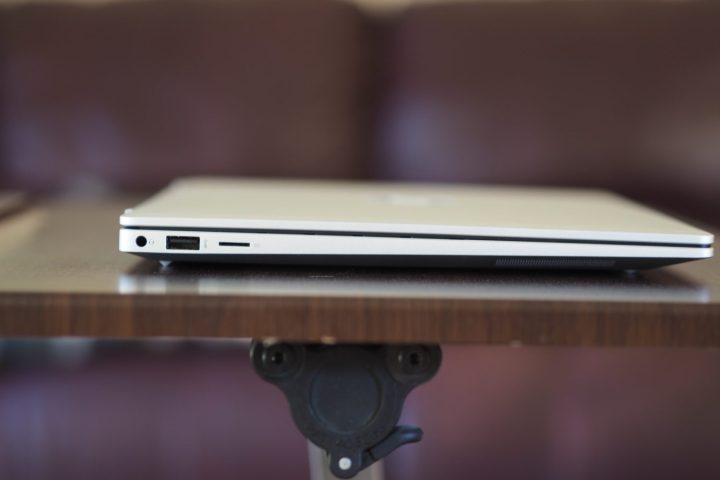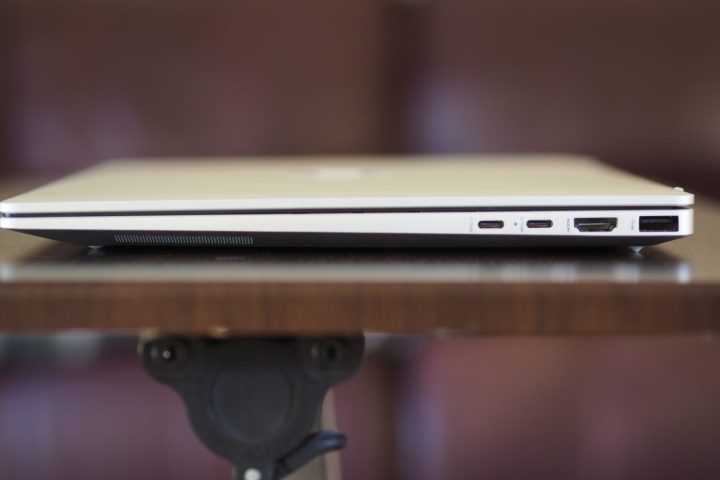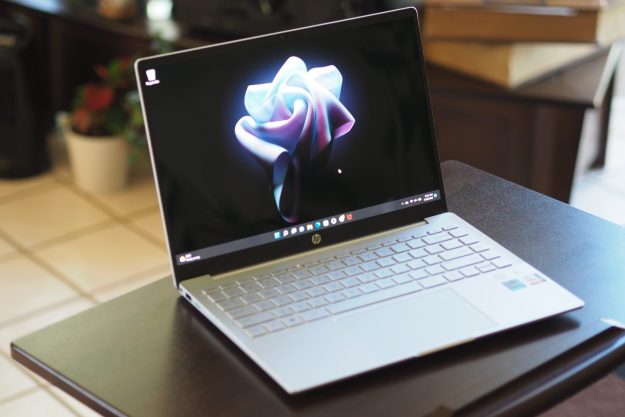
- Spectacular 90Hz OLED display
- Class-leading build quality
- Excellent keyboard and touchpad
- Solid productivity performance
- Strong value at sale prices
- Review unit performance limited by throttling
- Poor battery life
HP’s Pavilion line carries its budget to mid-range laptops, and it’s offered some solid options over the years. For 2022, the company decided to upscale the line with the Pavilion Plus 14, a laptop that’s the thinnest Pavilion yet and the first with an OLED display. And it’s a 90Hz display, offered at an extremely attractive price.
It’s a competitive market, though, and HP has its job cut out.
My review unit is currently on sale at HP.com for $850, down from $1,000. That’s a compelling price for a 12th-gen Intel Core i7-12700H CPU and a 14-inch 16:10 2.8K (2880 x 1800) OLED display running at 90Hz. In fact, it’s one of the least expensive OLED laptops around, and it’s a step up from most, thanks to the display’s faster refresh rate. There are other excellent deals available, and if you can get the Pavilion Plus 14 at one of its sale prices, you’re getting an outstanding laptop for a fantastic price.
Design
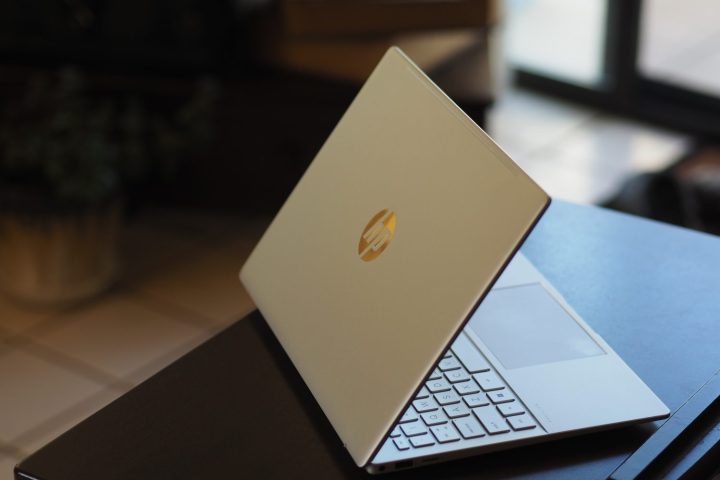
The Pavilion Plus 14 is constructed of all aluminum, and you can tell. The chassis and lid evoke confidence in the laptop’s durability thanks to a lack of twisting, bending, or flexing. The Pavilion Plus 14 is as robust as some
Even the Pavilion Plus 14’s hinge is well-designed, allowing the lid to be opened with one hand while holding the display firmly in place. The Dell Inspiron 14 2-in-1 and Asus Vivobook S 14X retail for around the same price as the Pavilion Plus 14, and neither are as rigid in their construction.
The laptop’s design is simple and streamlined, with five available colors — Natural Silver, Tranquil Pink, Mineral Silver (dark gray), Warm Gold, and Space Blue. My review unit was the silver model, sporting a minimalist but attractive aesthetic. That’s common among
The Pavilion Plus 14 has been slimmed down compared to other Pavilion
There are plenty of ports, with two USB-C 3.2 Gen 2 ports, 2 USB-A 3.2 Gen 1 ports, a full-size
Price and configurations
As of when this review is being written, most configurations of the Pavilion Plus 14 are heavily discounted. The best deal is the entry-level model that’s $550 at Staples (on sale from $780) with a 12th-gen Intel Core i5-1240P CPU, 8GB of RAM, a 256GB SSD, and a 14-inch 2.2K (2240 x 1400) IPS display. The Core i5-1240P is a 28-watt 12-core (four Performance and eight Efficient) and 16-thread processor running at a max frequency of 4.4GHz.
My review unit retails for $1,000 but is on sale for $850, with a Core i7-12700H (see the performance section), 16GB of
The Asus Vivobook S 14X is similarly priced at retail, $1,100 for a Core i7-12700H, 12GB of
Performance
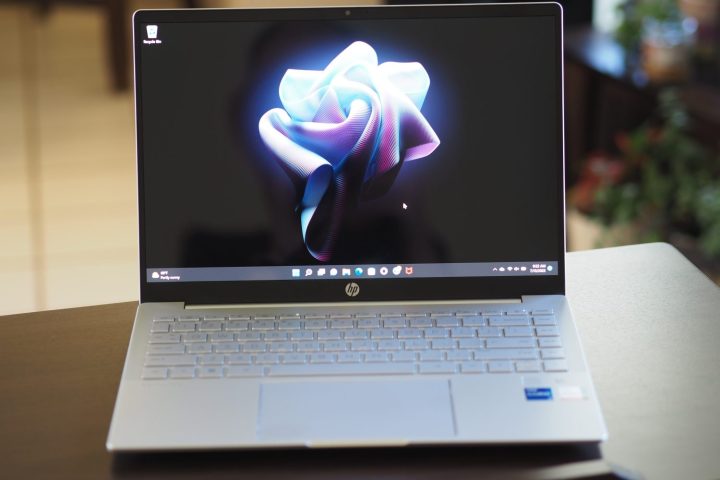
My review unit was built around the 12th-gen Intel Core i7-12700H, a 45-watt CPU with 12 cores (four Performance and eight Efficient) and 16 threads. It’s a processor that we don’t often see in thin-and-light ultrabooks like the Pavilion Plus 14, which typically equip 28-watt Intel P-Series or 15-watt U-Series CPUs. Also unusual is that the Pavilion Plus 14 is limited to Intel’s integrated Iris Xe graphics. Usually, the 45-watt CPUs are paired with discrete graphics.
We have one comparison machine that also used a Core i7-12700H and Iris Xe graphics, the Asus Vivobook S 14X. Looking at our benchmarks, the Pavilion Plus 14 had a similar performance. In Geekbench 5, its single-core scores were lower but its multi-core scores were higher. It was essentially tied in our Handbrake test that encodes a 420MB video as H.265, and it was slower in Cinebench R23. Both
Another similarity between the two
The biggest difference is that the Pavilion Pro 14 can be configured with the 28-watt Core i5-1240P, which could provide similar performance if it throttles less, and the 15-watt Core i7-1255U, which would presumably offer improved efficiency. And, the HP is significantly less expensive than the Asus in most of its configurations.
Ultimately, my review unit performed well for an $850 laptop and okay for a retail price of $1,000. It’s going to keep up with demanding productivity workflows, and it can do some very lightweight creative tasks as well. As I just mentioned, though, the 45-watt CPU is wasted on the thin chassis, and HP might have been better off going with the Core i7-1260P.
| Geekbench (single / multi) |
Handbrake (seconds) |
Cinebench R23 (single / multi) |
|
| HP Pavilion Plus 14 (Core i7-12700H) |
Bal: 1,462 / 8,531 Perf: 1,472 / 8,531 |
Bal: 104 Perf: 102 |
Bal: 1,523 / 8,358 Perf: 1,716 / 10,915 |
| Asus Vivobook S 14X (Core i7-12700H) |
Bal: 1,595 / 6,692 Perf: 1,681 / 7,175 |
Bal: 113 Perf: 102 |
Bal: 1,757 / 10,339 Perf: 1,792 / 12,051 |
| Dell XPS 15 9520 (Core i7-12700H) |
Bal: 1,470 / 9,952 Perf: 1,714 / 11,053 |
Bal: 100 Perf: 77 |
Bal: 1,509 / 11,578 Perf: 1,806 / 13,313 |
| Dell Inspiron 14 2-in-1 (Core i7-1255U) |
Bal: 1,703 / 6,520 Perf: 1,685 / 6,791 |
Bal: 153 Perf: 141 |
Bal: 1,729 / 6,847 Perf: 1,773 / 7,009 |
| Lenovo ThinkPad X1 Yoga Gen 7 (Core i7-1260P) |
Bal: 1,650 / 8,080 Perf: 1,621 / 8,544 |
Bal: 116 Perf: 120 |
Bal: 1,587 / 7,682 Perf: 1,611 / 8,078 |
| Lenovo Yoga 9i 14 Gen 7 (Core i7-1260P) |
Bal: 1,717 / 9,231 Perf: 1,712 / 10,241 |
Bal: 130 Perf: 101 |
Bal: 1,626 / 7,210 Perf: 1,723 / 8,979 |
| Asus Zenbook S 13 OLED (Ryzen 7 6800U) |
Bal: 1,417 / 6,854 Perf: 1,404 / 7,223 |
Bal: 112 Perf: 111 |
Bal: 1,402 / 8,682 Perf: 1,409 / 8,860 |
The Pavilion Plus 14 can be configured with up to an Nvidia GeForce RTX 2050, but my review unit used Intel Iris Xe graphics. It scored slightly below average in the 3DMark Time Spy test, but its Fortnite performance was around average at 15 frames per second (fps) at 1200p and epic graphics. It’s not a gaming laptop unless you limit your library to older titles and eSports games.
| 3DMark Time Spy |
Fortnite (1080p/1200p Epic) |
|
| HP Pavilion Plus 14 (Intel Iris Xe) |
Bal: 1,520 Perf: 1,577 |
Bal: 15 Perf: 16 |
| Asus Vivobook S 14X (Intel Iris Xe) |
Bal: 1,251 Perf: 1,253 |
Bal: 6 Perf: 7 |
| Lenovo ThinkPad X1 Yoga Gen 7 (Intel Iris Xe) |
Bal: 1,899 Perf: 1,886 |
Bal: 17 fps Perf: 16 fps |
| MSI Summit E14 Flip (Intel Iris Xe) |
Bal: 1,740 Perf: 1,959 |
Bal: 15 fps Perf: 19 fps |
| Lenovo Yoga 9i 14 Gen 7 (Intel Iris Xe) |
Bal: 1,658 Perf: 1,979 |
Bal: 12 fps Perf: N/A |
| LG Gram 16 2-in-1 (Intel Iris Xe) |
Bal: 1,746 Perf: 1,919 |
Bal: 15 fps Perf: 20 fps |
| Asus Zenbook S 13 OLED (AMD Radeon) |
Bal: 2,110 Perf: 2,213 |
Bal: 19 fps Perf: 19 fps |
Display and audio

One of the most important recent advances in display technology is the widespread adaptation of OLED panels. They provide brighter and more accurate colors and deeper blacks, making for excellent productivity, creativity, and media consumption displays. If you can get an OLED display for less than $1,000, that’s a terrific value proposition, and when that display runs at 90Hz, it’s even better. Higher refresh rates help make Windows 11 a smoother experience, not to mention allowing games to run tear-free at higher frame rates (not that we’re worried about that with integrated graphics).
My review unit was configured with the 2.8K (2880 x 1800) 90Hz OLED display, and it was beautiful out of the box. If I’d spent $850 on the laptop, I’d be tickled pink with the bright and accurate colors, inky blacks, and smooth
According to my colorimeter, HP didn’t cut any corners with the display. Brightness was excellent at 398 nits, well above our threshold of 300 nits for working in all lighting conditions except direct sunlight. Colors were wide at 100% of sRGB and 95% of AdobeRGB, and they were extremely accurate at a DeltaE of 0.78 (1.0 or less is indistinguishable to the human eye). And, of course, the contrast was extremely deep at 27,830:1, making for inky blacks.
This is a spectacular display at any price; it’s a steal at $1,000 or less. It’s a display that will please everyone, from productivity workers to creators to hardcore media consumers.
| Brightness (nits) |
Contrast | sRGB gamut | AdobeRGB gamut | Accuracy DeltaE (lower is better) |
|
| HP Pavilion Plus 14 (OLED) |
398 | 27,830:1 | 100% | 95% | 0.78 |
| Asus Vivobook S 14X (OLED) |
403 | 27,930:1 | 100% | 99% | 1.07 |
| Lenovo ThinkPad X1 Yoga Gen 7 (IPS) |
386 | 1,900:1 | 100% | 81% | 0.78 |
| MSI Summit E14 Flip (IPS) |
516 | 1,320:1 | 100% | 89% | 1.10 |
| Lenovo Yoga 9i 14 Gen 7 (OLED) |
406 | 28,380:1 | 100% | 95% | 0.87 |
| Lenovo IdeaPad Slim 7i Pro (IPS) |
369 | 1,340:1 | 100% | 80% | 1.65 |
| Lenovo IdeaPad Slim 7 Carbon (OLED) |
397 | 27,590:1 | 100% | 96% | 0.88 |
Two downward-firing speakers on the front bottom of the chassis provide the audio, putting out very low volume sound. What they lacked in loudness, the speakers made up for in quality, with clear mids and highs and a surprising amount of bass. You’ll want some
Keyboard, touchpad, and webcam
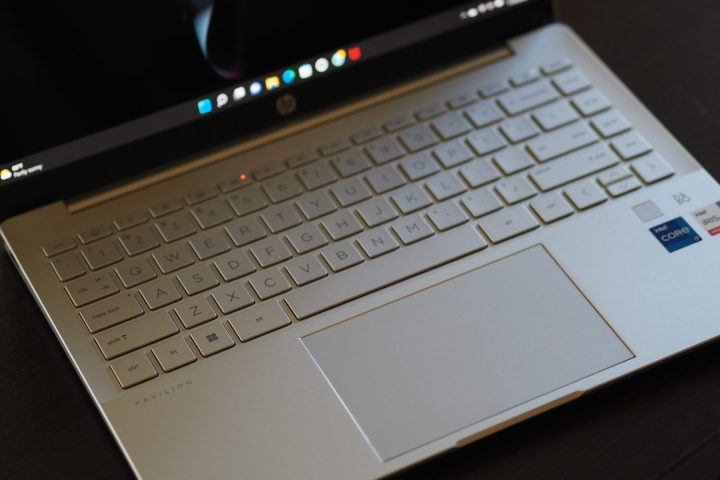
The Pavilion Plus 14 enjoys a nicely sized keyboard with large keycaps, and its switches are light with a precise bottoming action. It’s almost as good as the keyboard on HP’s Spectre line and has the same row of navigation keys on the right-hand side. As I was writing this review, I found the keyboard very comfortable for longer typing sessions.
The touchpad is large and has a smooth surface that makes for precise swiping with support for the full complement of
HP built a 5MP webcam into the Pavilion Plus 14 along with some technology to improve image quality. The video was smooth and detailed, much better than the average, and good enough to make for excellent videoconferencing.
Battery life
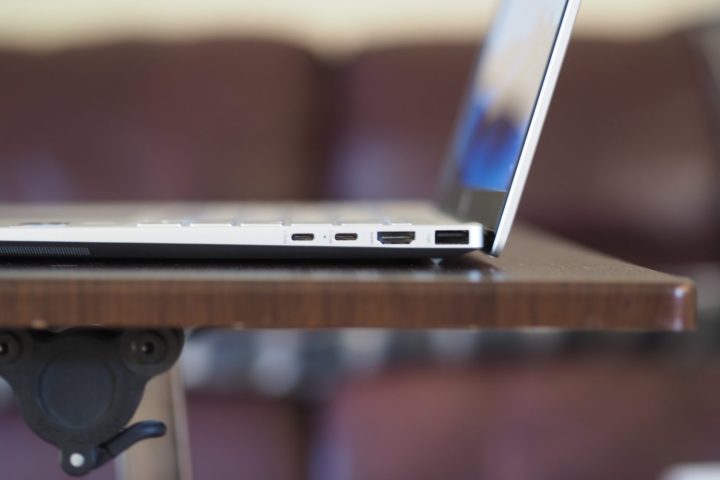
The Pavilion Plus 14 has 51 watt-hours of battery capacity, which is a little on the low side for a 14-inch laptop, and my review unit equipped a 45-watt CPU and a power-hungry high-res OLED display. I wasn’t expecting miracles in terms of battery life.
I didn’t get any. The Pavilion Plus 14 demonstrated below-average battery life in all our tests, starting with our web browsing test that cycles through a handful of complex websites, where it hit 4.5 hours. That’s around half of what we like to see in this test. In our video test that loops a local Full HD Avengers trailer, the HP managed just 7.5 hours, again well under average. And in the PCMark 10 Applications test that’s the best indication of productivity battery life, it hit just 4.75 hours, again significantly less than average.
Overall, the Pavilion Plus 14 is unlikely to get you through a full day of productivity tasks. You might be lucky to make it to lunch. The other configurations with lower-watt CPUs may do better, but my review unit configuration will need its charger kept handy.
| Web browsing | Video | PCMark 10 Applications |
|
| HP Pavilion Plus 14 (Core i7-12700H) |
4 hours, 29 minutes | 7 hours, 29 minutes | 5 hours, 48 minutes |
| Asus Vivobook S 14X (Core i7-12700H) |
6 hours, 20 minutes | 8 hours, 18 minutes | 7 hours, 1 minute |
| Dell XPS 15 9520 (Core i7-12700H) |
9 hours, 38 minutes | 12 hours, 40 minutes | 11 hours, 14 minutes |
| Lenovo ThinkPad X1 Yoga Gen 7 (Core i7-1260P) |
10 hours, 10 minutes | 16 hours, 12 minutes | 10 hours, 33 minutes |
| Lenovo Yoga 9i 14 Gen 7 (Core i7-1260P) |
9 hours, 10 minutes | 12 hours, 45 minutes | 8 hours, 32 minutes |
| Asus Zenbook S 13 OLED (Ryzen 7 6800U) |
8 hours, 4 minutes | 13 hours, 13 minutes | N/A |
| Lenovo IdeaPad Slim 7 Carbon (Ryzen 7 5800U) |
10 hours, 6 minutes | 11 hours, 12 minutes | 9 hours, 22 minutes |
Our take
The HP Pavilion Plus 14 isn’t the first thin-and-light laptop I’ve reviewed with a 45-watt CPU and, apparently, thermally limited performance. However, it’s much more forgivable at an $850 sale price with a spectacular 90Hz OLED display. The battery life is disappointing, but the build quality is excellent, as are the keyboard and touchpad. And as this review is being written, you can buy the Pavilion Plus 14 with a Core i5-1240P CPU and a 2.2K IPS display for as low as $550, which is a tremendous value.
The Pavilion Plus 14 is an attractive mid-range laptop even at full retail prices. And I can’t stress enough how nice it is to get such a great OLED display at such a low price.
Are there any alternatives?
There aren’t many
However, if you can spend a bit more, then Lenovo’s Yoga 9i Gen 7 is a solid option. It has its own incredible OLED display and a stunning new design, it performs similarly, and it has better battery life. As a convertible 2-in-1, it offers a more flexible form factor.
You could drop down in display size slightly and consider the Apple MacBook Air M2. Although it’s $1,200 with less
How long will it last?
The Pavilion Plus 14 is exceptionally well-built for a budget to mid-range laptop, and it should last for years of productive service. Its components are modern, although the lack of
Should you buy it?
Yes, if you can get it at a sale price. Performance is good if limited by the thin chassis, and the build quality, keyboard, and touchpad are all excellent. Battery life is a disappointment, though, with the review configuration. Other configurations with lower-watt CPUs might last longer.

